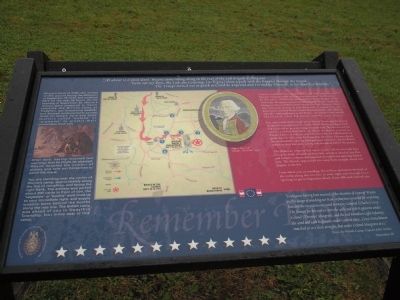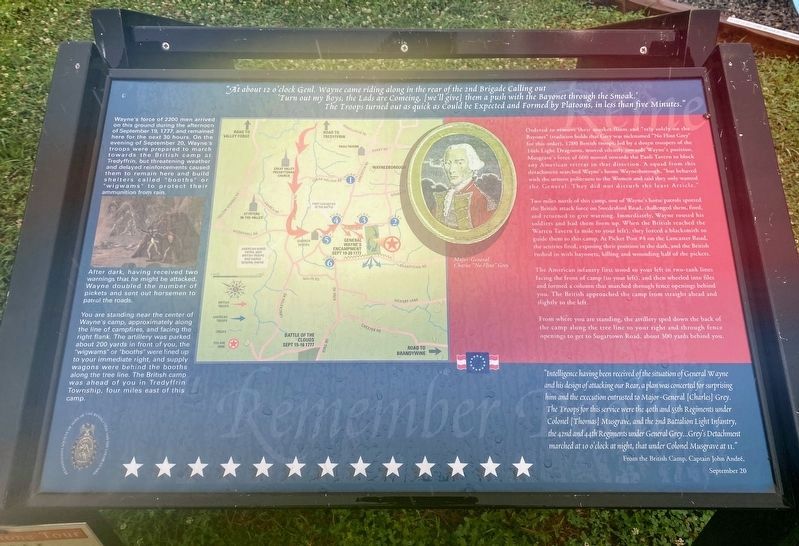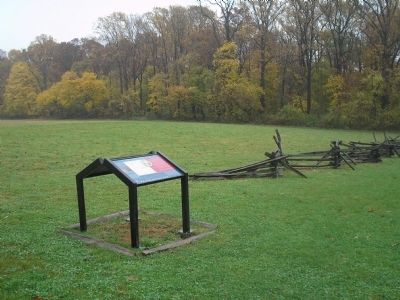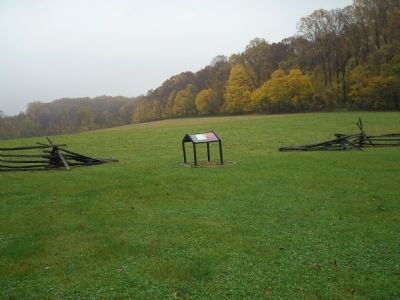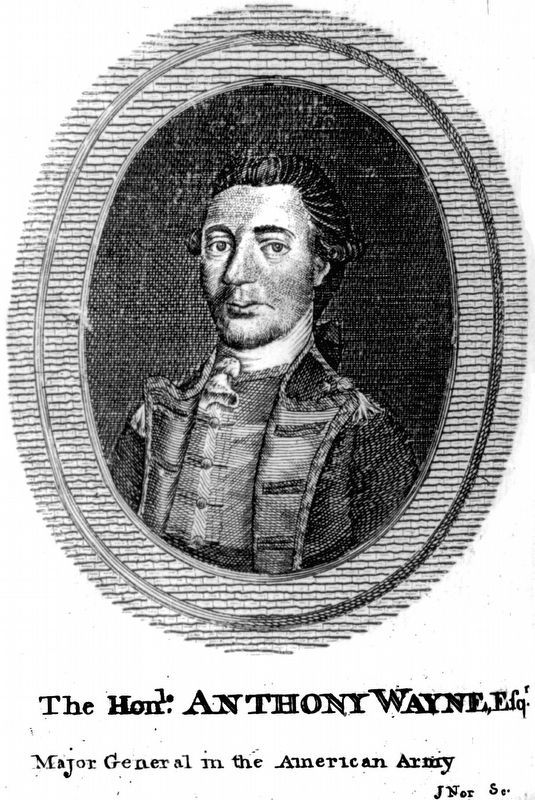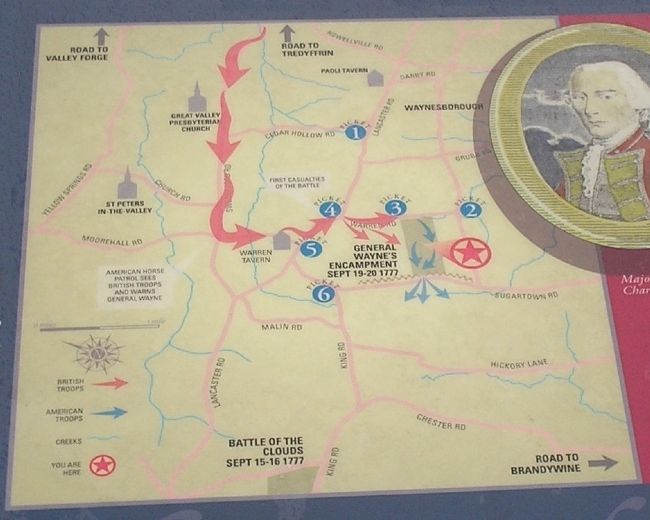Malvern in Chester County, Pennsylvania — The American Northeast (Mid-Atlantic)
General Wayne’s Encampment
Sept 19-29 1777
“At about 12 o’clock Genl. Wayne came riding along in the rear of the 2nd Brigade Calling out ‘Turn out my Boys, the Lads are Comeing, [we’ll give] them a push with the Bayonet through the Smoak.’ The Troops turned out as quick as Could be Expected and Formed by Platoons, in less than five Minutes.”
Ordered to remove their musket flints and “rely solely on the Bayonet” (tradition holds that Grey was nicknamed “No Flint Grey” for this order), 1200 British troops led by a dozen troopers of the 16th Light Dragoons, moved silently towards Wayne’s position. Musgrave’s force of 600 moved towards the Paoli Tavern to block any American retreat in that direction. A squad from this detachment searched Wayne’s home Waynesborough, “but behaved with the utmost politeness to the Women and said they only wanted the General. They did not disturb the least Article.”
Two miles north of this camp, one of Wayne’s horse patrols spotted the British attack force on Swedesford Road, challenged them, fired, and returned to give warning. Immediately, Wayne roused his soldiers and had them form up. When the British reached the Warren Tavern (a mile to your left), they forced a blacksmith to guide them to this camp. At Picket Post #4 on the Lancaster Road, the sentries fired, exposing their position in the dark, and the British rushed in with bayonets, killing and wounding half of the pickets.
The American infantry first stood to your left in two-rank lines facing the front of camp (to your left), and then wheeled into files and formed a column that marched through fence openings behind you. The British approached the camp from straight ahead and slightly to the left.
From where you are standing, the artillery sped down the back of the camp along the tree line to your right and through the fence openings to get to Sugartown Road, about 300 yards behind you.
“Intelligence having been received of the situation of General Wayne and his design of attacking our Rear, a plan was concerted for surprising him and the execution entrusted to Major-General [Charles] Grey. The Troops for this service were the 40th and 55th Regiments under Colonel [Thomas] Musgrave, and the 2nd Battalion Light Infantry, the 42nd and 44th Regiments under General Grey … Grey’s Detachment marched at 10 o’clock at night, that under Colonel Musgrave at 11.”
From the British Camp, Captain John André, September 20
Wayne’s force of 2200 men arrived on this ground during the afternoon of September 19, 1777, and remained here for the next 30 hours. On the evening of September 20, Wayne’s troops were prepared to march towards the British camp at Tredyffrin, but threatening weather and delayed reinforcements caused them to remain here and build shelters called “booths” or “wigwams” to protect their ammunition from the rain.
After dark, having received two warnings that he might be attacked, Wayne doubled the number of pickets and sent out horsemen to patrol the roads.
You are standing near the center of Wayne’s camp, approximately along the line of campfires, and facing the right flank. The artillery was parked about 200 yards in front of you, the “wigwams” or “booths” were lined up to your immediately right, and supply wagons were behind the booths along the tree line. The British camp was ahead of you in Tredyffrin Township, four miles east of this camp.
Topics. This historical marker is listed in these topic lists: Notable Events • Notable Places • War, US Revolutionary. A significant historical date for this entry is September 20, 1782.
Location. 40° 1.805′ N, 75° 31.054′ W. Marker is in Malvern, Pennsylvania, in Chester County. Marker is on Monument Avenue, on the left when traveling west. Marker is on the Paoli Battlefield. Touch for map. Marker is in this post office area: Malvern PA 19355, United States of America. Touch for directions.
Other nearby markers. At least 8 other markers are within walking distance of this marker. "…The most dreadful scene I have ever beheld." (here, next to this marker); "Losing a wheel and crashing into a gap in the fence line"... (a few steps from this marker); “A Dreadful scene of havock” (within shouting distance of this marker); The Paoli Battlefield (within shouting distance of this marker); Camp Life (within shouting distance of this marker); Battlefield Site Map (about 300 feet away, measured in a direct line); This Wall (about 300 feet away); Paoli Massacre Monument (about 300 feet away). Touch for a list and map of all markers in Malvern.
More about this marker. The marker contains a map of General Wayne’s Sept 19-20, 1777 encampment, showing American and British troop movements. Also on the marker is a picture of Major-General Charles “No Flint” Grey.
Related markers. Click here for a list of markers that are related to this marker. This series of markers follow the walking trail of the Paoli Battlefield.
Also see . . . The Battle of Paoli also known as the Paoli Massacre. A British perspective of the battle from BritishBattles.com (Submitted on November 11, 2008, by Bill Coughlin of Woodland Park, New Jersey.)
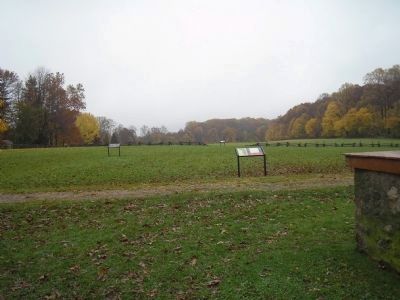
Photographed By Bill Coughlin, November 6, 2008
5. Paoli Battlefield
This photo looks in the direction of the British attack on the night of September 20, 1777. Several markers are at this location, the site of Gen. Wayne's camp. The "General Wayne's Encampment" marker is the one in the distance by the fenceline.
Credits. This page was last revised on May 21, 2021. It was originally submitted on November 11, 2008, by Bill Coughlin of Woodland Park, New Jersey. This page has been viewed 1,181 times since then and 39 times this year. Photos: 1. submitted on November 11, 2008, by Bill Coughlin of Woodland Park, New Jersey. 2. submitted on May 12, 2021, by Shane Oliver of Richmond, Virginia. 3, 4, 5. submitted on November 11, 2008, by Bill Coughlin of Woodland Park, New Jersey. 6. submitted on February 21, 2021, by Allen C. Browne of Silver Spring, Maryland. 7. submitted on November 11, 2008, by Bill Coughlin of Woodland Park, New Jersey.
